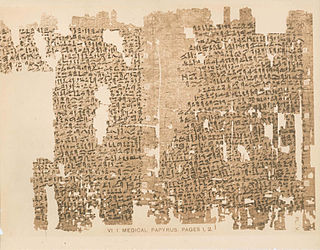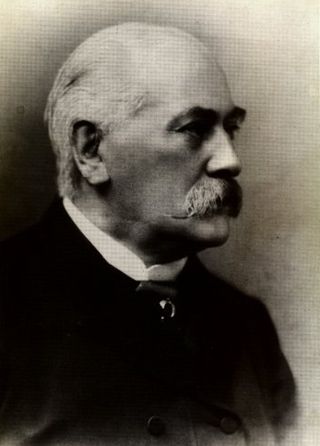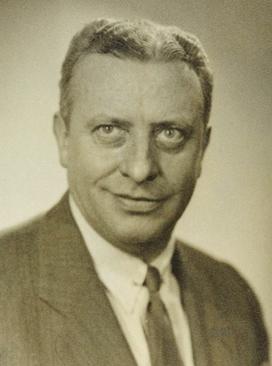Related Research Articles

Papyrus is a material similar to thick paper that was used in ancient times as a writing surface. It was made from the pith of the papyrus plant, Cyperus papyrus, a wetland sedge. Papyrus can also refer to a document written on sheets of such material, joined side by side and rolled up into a scroll, an early form of a book.

The Ebers Papyrus, also known as Papyrus Ebers, is an Egyptian medical papyrus of herbal knowledge dating to c. 1550 BCE. Among the oldest and most important medical papyri of Ancient Egypt, it was purchased at Luxor in the winter of 1873–1874 by the German Egyptologist Georg Ebers. It is currently kept at the Leipzig University Library in Germany.

The Elephantine Papyri and Ostraca consist of thousands of documents from the Egyptian border fortresses of Elephantine and Aswan, which yielded hundreds of papyri and ostraca in hieratic and demotic Egyptian, Aramaic, Koine Greek, Latin and Coptic, spanning a period of 100 years in the 5th to 4th centuries BCE. The documents include letters and legal contracts from family and other archives, and are thus an invaluable source of knowledge for scholars of varied disciplines such as epistolography, law, society, religion, language and onomastics. The Elephantine documents include letters and legal contracts from family and other archives: divorce documents, the manumission of slaves, and other business. The dry soil of Upper Egypt preserved the documents.
Ancient Egyptian mathematics is the mathematics that was developed and used in Ancient Egypt c. 3000 to c. 300 BCE, from the Old Kingdom of Egypt until roughly the beginning of Hellenistic Egypt. The ancient Egyptians utilized a numeral system for counting and solving written mathematical problems, often involving multiplication and fractions. Evidence for Egyptian mathematics is limited to a scarce amount of surviving sources written on papyrus. From these texts it is known that ancient Egyptians understood concepts of geometry, such as determining the surface area and volume of three-dimensional shapes useful for architectural engineering, and algebra, such as the false position method and quadratic equations.

The Westcar Papyrus is an ancient Egyptian text containing five stories about miracles performed by priests and magicians. In the papyrus text, each of these tales are told at the royal court of king Khufu (Cheops) by his sons. The story in the papyrus usually is rendered in English as, "King Cheops and the Magicians" and "The Tale of King Cheops' Court". In German, into which the text of the Westcar Papyrus was first translated, it is rendered as Die Märchen des Papyrus Westcar.

The Edwin Smith Papyrus is an ancient Egyptian medical text, named after Edwin Smith who bought it in 1862, and the oldest known surgical treatise on trauma. From a cited quotation in another text, it may have been known to ancient surgeons as the "Secret Book of the Physician".

The medicine of the ancient Egyptians is some of the oldest documented. From the beginnings of the civilization in the late fourth millennium BC until the Persian invasion of 525 BC, Egyptian medical practice went largely unchanged and included simple non-invasive surgery, setting of bones, dentistry, and an extensive set of pharmacopoeia. Egyptian medical thought influenced later traditions, including the Greeks.
In mathematics, ancient Egyptian multiplication, one of two multiplication methods used by scribes, is a systematic method for multiplying two numbers that does not require the multiplication table, only the ability to multiply and divide by 2, and to add. It decomposes one of the multiplicands into a set of numbers of powers of two and then creates a table of doublings of the second multiplicand by every value of the set which is summed up to give result of multiplication.

Chauncey Depew Leake was an American pharmacologist, medical historian and ethicist. Leake received a bachelor's degree with majors in biology, chemistry, and philosophy from Princeton University. He received his M.S. (1920) and Ph.D. (1923) from the University of Wisconsin in pharmacology and physiology.

Ancient Egyptian literature was written in the Egyptian language from ancient Egypt's pharaonic period until the end of Roman domination. It represents the oldest corpus of Egyptian literature. Along with Sumerian literature, it is considered the world's earliest literature.

The Kahun Gynaecological Papyrus is the oldest known medical text in Egyptian history, dated to c. 1825 BCE, during the Twelfth Dynasty.The Papyrus addresses gynecological health concerns, pregnancy, fertility, and various treatments.

Egyptian medical papyri are ancient Egyptian texts written on papyrus which permit a glimpse at medical procedures and practices in ancient Egypt. These papyri give details on disease, diagnosis, and remedies of disease, which include herbal remedies, surgery, and magical incantations. Many of these papyri have been lost due to grave robbery. The largest study of the medical papyri to date has been undertaken by Humboldt University of Berlin and was titled Medizin der alten Ägypter.

The Hearst Papyrus, also called the Hearst Medical Papyrus, is one of the medical papyri of ancient Egypt. It was named after Phoebe Hearst. The papyrus contains 18 pages of medical prescriptions written in hieratic Egyptian writing, concentrating on treatments for problems dealing with the urinary system, blood, hair, and bites. It is dated to the first half of the 2nd millennium BC. It is considered an important manuscript, but some doubts persist about its authenticity.

The Brooklyn Papyrus is a medical papyrus dating from ancient Egypt and is one of the oldest preserved writings about medicine and ophiology. The manuscript is dated to around 450 BCE and is today kept at the Brooklyn Museum in New York.
The Carlsberg papyrus is an ancient Egyptian medical papyrus written in hieratic. The recto concerns eye diseases and the verso deals with birth prognoses. The recto text dates to the 18th Dynasty, while the verso was recorded several generations later. The papyrus is one of very few medical texts surviving from pharaonic Egypt.

The Brugsch Papyrus, also known as the Greater Berlin Papyrus or simply Berlin Papyrus, is an important ancient Egyptian medical papyrus. It was discovered by Giuseppe Passalacqua in Saqqara, Egypt. Friedrich Wilhelm IV of Prussia acquired it in 1827 for the Berlin Museum, where it is still housed. The style of writing is that of the 19th Dynasty, and it is dated between 1350 and 1200 BC.
Walter Wreszinski was a German Egyptologist and professor at Albertus University of Königsberg.
This page list topics related to ancient Egypt.

The London Medical Papyrus is an ancient Egyptian papyrus in the British Museum, London. The writings of this papyrus are of 61 recipes, of which 25 are classified as medical while the remainder are of magic. The medical subjects of the writing are skin complaints, eye complaints, bleeding and burns.

John Farquhar Fulton was an American neurophysiologist and historian of science. He received numerous degrees from Oxford University and Harvard University. He taught at Magdalen College School of Medicine at Oxford and later became the youngest Sterling Professor of Physiology at Yale University. His main contributions were in primate neurophysiology and history of science.
References
- 1 2 Sadek, Ashraf Alexandre (January 2001). "Some Aspects of Medicine in Pharonic Egypt". History of Medicine. Australian Academy of Medicine & Surgery. Archived from the original on 2019-03-05. Retrieved 2022-03-24.
- ↑ Leake, Chauncey D. (1952). The Old Egyptian Medical Papyri. Logan Clendening Lectures on the History and Philosophy of Medicine, Second Series. Lawrence, Kansas: University of Kansas Press. p. 9. hdl:1808/6339. LCCN 52012678.
- ↑ Leake, Chauncey D. (1952). The Old Egyptian Medical Papyri. Logan Clendening Lectures on the History and Philosophy of Medicine, Second Series. Lawrence, Kansas: University of Kansas Press. p. 15. hdl:1808/6339. LCCN 52012678.
- ↑ Leake, Chauncey D. (1952). The Old Egyptian Medical Papyri. Logan Clendening Lectures on the History and Philosophy of Medicine, Second Series. Lawrence, Kansas: University of Kansas Press. p. 14. hdl:1808/6339. LCCN 52012678.